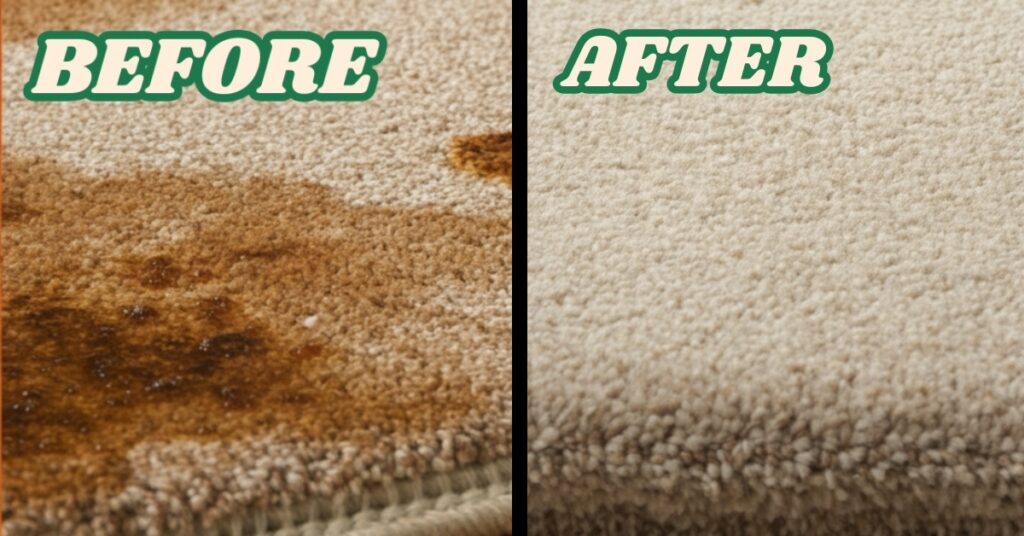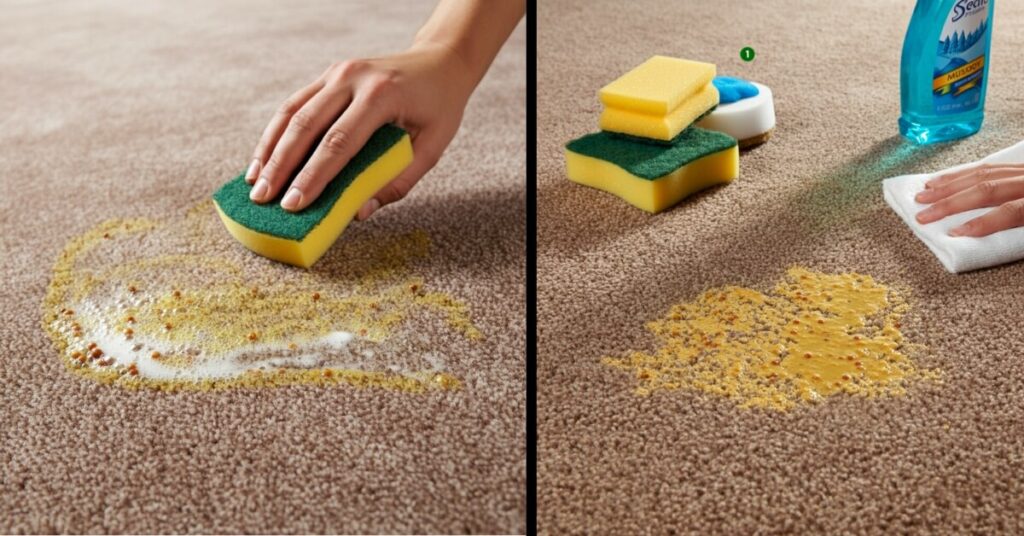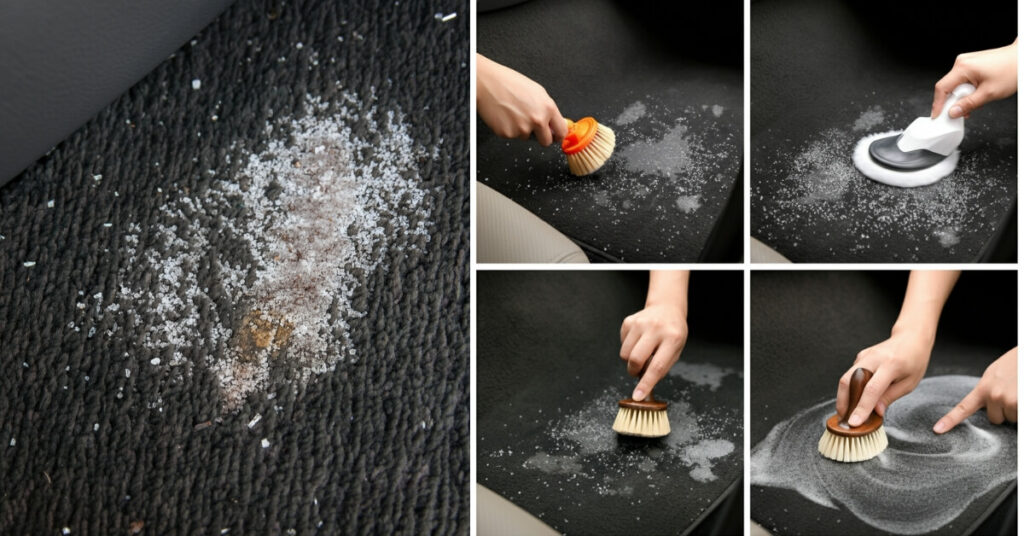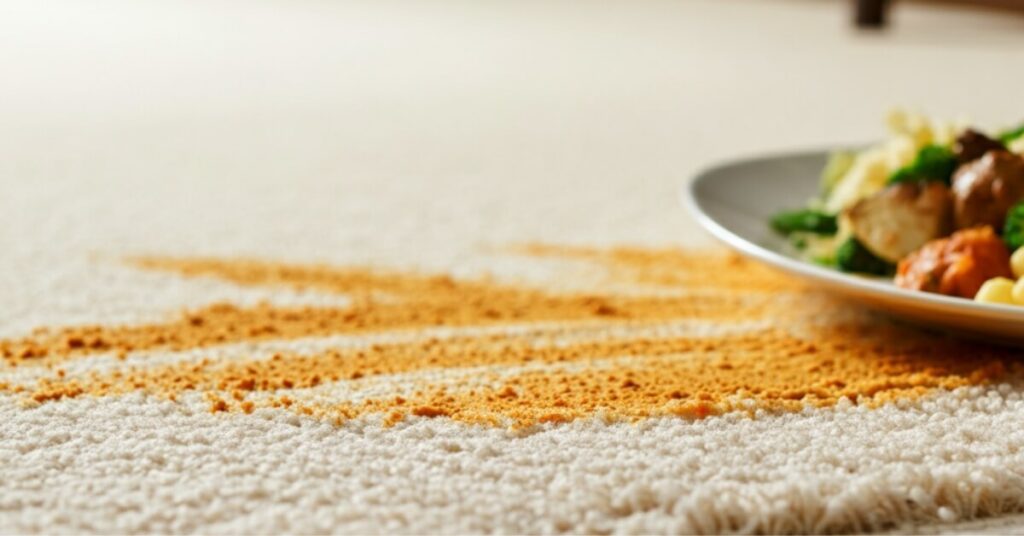As an Amazon Associate, I earn from qualifying purchases.
How to Remove Turmeric Stains from Carpet can feel like a daunting task. Turmeric brings delightful spice and vibrant color to countless dishes, but when it spills onto your carpet, it quickly turns into a cleaning nightmare. The vivid yellow pigment, binds stubbornly to carpet fibers, and even the toughest cleaning products often struggle to lift it.
That’s why the timely ‘tackle-and-turmeric’ strategy, acting fast and using the right combination of household ingredients like baking soda, dish soap, and hydrogen peroxide, paired with a bit of cleaning patience, works wonders in restoring your carpet’s spotless look.
This guide provides everything you need to know about removing tough turmeric stains, including why they are so challenging to remove, recommended products, cleaning solutions to prevent permanent marks, and answers to some frequently asked questions. In this article, you will learn how to tackle even the toughest turmeric stains confidently.
Contents Overview
Understanding Why Turmeric Stains Are Difficult To Remove
First of all, why does turmeric prove so hard to clean up? In short, it is largely due to curcumin— it’s a great natural pigment that has been used as a dye and cooking ingredient for centuries. It provides a golden glow to foods. Because of this, if not addressed in a timely manner, it can ruin a pristine carpet.
- The Natural Dyeing process: The dye properties of Curcumin bind to carpet fibers on a molecular level. When it seeps into the material, it is not sitting on the surface; instead, it is fused within the carpet.
- Sunlight Sensitivity: The relationship between sunlight and stains is rather straightforward. When the stains of turmeric are subjected to sunlight, ultraviolet rays can modify and intensify the curcumin pigment, making it more difficult to remove.
- Heat Activation: Just as heat promotes the aromas of spices in your kitchen, it also empowers turmeric stains in your carpet. Warm air or hot water can cause the pigment to bond irreversibly to the fibers.
With these combined factors, it becomes clear why turmeric stains are far more intricate than other food stains like juice or ketchup. Immediate and precise action is essential.
How To Get Turmeric Stain Out of Carpet (Step by Step Cleanup Guide)
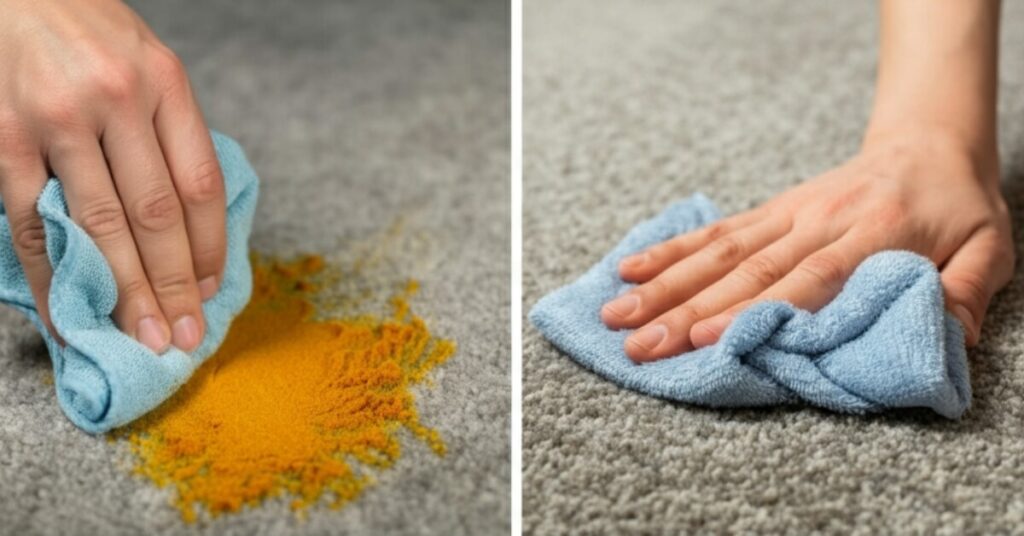
When turmeric comes in contact with your carpet, time is of the essence. Following these guidelines will greatly increase your chances of restoring your carpet’s original appearance without resorting to harsh chemicals or professional help.
Step 1. Blot the Stain (Do Not Rub)
If the spill is recent, your goal is to contain damage as much as possible and prevent the stain from penetrating deeper.
- To begin tackling the stain, grab a clean, dry cloth or paper towels, and blot the area gently.
- As tempting as it may be to rub the blot with the cloth, don’t. Rubbing will make the turmeric stubbornly set deeper in the fabric, and the yellow staining will spread.
- Using a dull knife or spoon, scrape off any solid residues, such as bits of food. Do not try to push them into the carpet. Be careful not to smear it in, either.
Removing the maximum amount of liquid possible at this stage lets you achieve better results in terms of complete removal.
Step 2: Scrape Off Dried Residue
Use the edge of a spoon or a dull butter knife to lift off any spent residue of turmeric if the spill is already dried or partially set. It is important to keep the blade at a slight angle to the carpet and gently massage the residue off. Use turmeric residue to your advantage while cleaning the carpet. The more residue you remove, the easier the cleaning process becomes.
Step 3: Prepare a Cleaning Solution
You can mix dish soap, white vinegar, and cold water for a potent cleanser for turmeric stains. This combination works on grime, along with breaking down inorganic residue and rinsing away clean.
- In a bowl, mix 2 tbsp of vinegar, 2 cups of cold water, and 1 tsp Mrs. Meyer’s or Dawn dish soap for a gentle stain buster.
- Using a bowl or a spray bottle, give the mixture a gentle shake or stir to combine. Avoid hot water, as it sets stains deeper.
- You can either pour the mixture into a spray bottle for easy application or dip a cloth directly into the solution.
Step 4: Apply the Solution
Make sure to saturate the area containing the stain with the mixture.
- Using a clean white cloth, lightly spray or dampen it with the cleaning solution. Instead of rubbing, press the cloth onto the stain and blot.
- Work from the outer edge towards the center. This controls the turmeric and stops it from spreading further.
- Rotate the cloth to a clean section regularly so the turmeric can attach itself to the cloth instead of the carpet.
- Now, the color should start lifting. If necessary, repeating the above steps helps until the yellow residue lightens considerably.
Step 5: Rinse and Blot Dry
Just like the cleaning solution, rinsing it off is equally important.
- Grab a fresh, clean cloth, dampen it with cold water, and blot the area to lift detergent and any remaining pigment.
- Repeat with clean water as required – leaving soap can become harmful later on.
- To enhance the drying process, use a white towel to soak up the remaining moisture.
- Skipping the rinsing step will likely leave a residue that might form a gray patch or attract dirt, which nullifies the whole effort you have put in.
Step 6: Baking Soda + Hydrogen Peroxide for Stubborn Stains
Don’t worry if you happen to have stubborn yellow stains on your carpet. For light-colored carpets, baking soda and hydrogen peroxide mixed together work wonders, but always perform a test on an inconspicuous area first.
- Combine 1 tablespoon of baking soda with 2 tablespoons of hydrogen peroxide until it forms a semi-thick paste.
- Carefully apply the paste to the stubborn yellow areas.
- Let it rest for 10 to 15 minutes, but do not let it dry completely.
- Using damp cloths, clean the area until all residue is gone. After that, rinse with cold water and dry with a towel.
- Be careful with hydrogen peroxide as it can bleach and lighten carpet fibers, so only use it on very light carpets.
Step 7: Let the Carpet Dry Naturally
Good ventilation can speed up drying. Open windows or set a small fan near the cleaned area. Avoid sunlight, especially while drying, as any leftover stain can become more pronounced if exposed before full removal. Once the damp area is completely dry, feel free to run a vacuum over it, learn how to dry carpet after cleaning. This will not just restore the carpet’s texture, but also help in blending the cleaned portion with the rest of the carpet.
Expert Tip: Manually cleaning a large area or more impactful stains? A wet/dry vacuum and/or carpet extractor will help lift any leftover residue.
Best Cleaning Solutions for Turmeric Stains
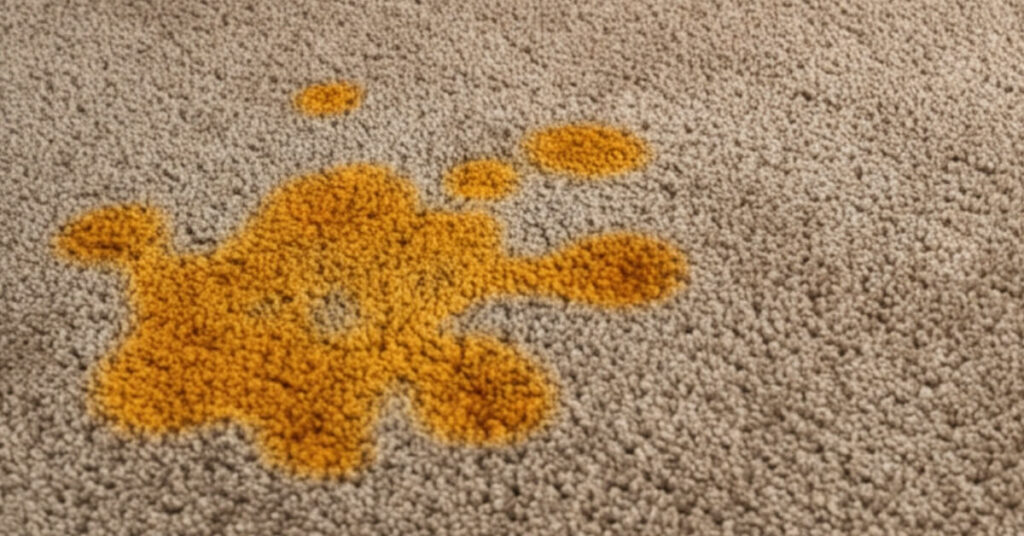
No matter whether you prefer tried and tested commercial products or DIY methods, these effective solutions will help combat turmeric stains:
1. White Vinegar + Dish Soap
As with many greasy and organic stains, this homemade solution works like a charm. It rinses off easily, ensuring no harm to the carpet.
Recommended: Mrs. Meyer’s Clean Day Dish Soap: Gentle, plant-based option. Heinz Cleaning Vinegar: Unscented and effective.
2. Baking Soda Paste
Mildly abrasive, baking soda works well on stubborn pigments. Mix it into a paste, apply it for targeted spot treatment, or for old faint yellow stains, sprinkle, allow time, and vacuum.
Suggestions: Arm & Hammer Baking Soda: A brand you can always count on.
3. Hydrogen Peroxide
It is a strong natural bleaching agent useful for very pale or white carpets. Do not apply to dark shades.
4. Lemon Juice
Due to the mild acidity, lemons can clean and deodorize. However, lemon juice can lighten carpet fibers, so do a test first.
Tip: For minor and fresh stains, use lemon juice with a pinch of baking soda. After applying the paste, let it fizz and then blot as normal once fizzing stops.
5. Carpet Cleaners
Some stubborn stains require more intensive methods. These organic stain removers are specifically designed for carpets to deal with tough stains while protecting the sensitive fibers.
Suggested: Folex Instant Carpet Spot Remover: Known to work for many types of stains. BISSELL Professional Oxy Stain Destroyer: Capable of removing stubborn pigment stains, including turmeric.
6. Enzyme Cleaners
Enzyme cleaners are primarily used for protein stains but can also help dissolve leftover organic matter. Make sure to look for carpet-safe products and always conduct a test patch.
How to Prevent Yellowing Stains
While it is important to know how to manage turmeric spills, the following professional techniques help prevent long-term yellowing damage:
- Avoid hot water: Do not use steam cleaners, hot water, or cleaning appliances at any stage. Curcumin, the yellow component of turmeric, bonds with fibers when heated, setting the stain and making it nearly impossible to fully remove.
- Do not allow sunlight to hit the stain: Move curtains or rugs to block windows if you are cleaning near a bright area. Sun worsens discoloration while also making fade removal harder.
- Always test new solutions: Make sure to inspect the carpet’s color using a small test patch for texture and discoloration. With hydrogen peroxide and lemon, extra caution is advised due to a stronger bleaching action.
- Take action every time: The best way to prevent staining is to take prompt action. If you let excess turmeric sit, it increases the likelihood of bonding with fibers.
- Blotting inwards: Blotting in this manner helps keep the stain confined to the smallest possible area and prevents the stain from spreading.
- Gentle step repetition: Gently repeating gentle steps is often better than a single aggressive deep clean that could damage the carpet.
- Additional Recommendation: Consider placing machine-washable rugs or mats in spill-prone areas. These are easier to clean and replace compared to wall-to-wall carpets.
Final Thoughts
While turmeric stains may feel overwhelming, a little patience, the correct methods, and a few dedicated resources can work wonders. During stain removal, avoid any heat exposure or sunlight. Always remember that, with some stubborn stains, you may have to clean them multiple times before they fully lift—so stay determined and vigilant. If DIY methods fail, don’t hesitate to reach out to an industrial-grade cleaner with professional tools.
Provided you have the right information and cleaning supplies on hand, your carpet can stay fresh and free from turmeric stains, adding vibrant color to your home!
FAQs
1. Can turmeric permanently stain carpet?
Yes, turmeric’s curcumin pigment can permanently dye carpet fibers if not handled immediately and properly. Quick action, careful blotting, and spot testing are essential to prevent permanent yellowing.
2. Why does the stain get worse in sunlight?
Sunlight, especially UV rays, reacts with curcumin and causes the stain to set more deeply and appear even darker or brighter. Always cover or shade wet carpet areas until the stain is fully removed and dry.
3. Is hydrogen peroxide safe on colored carpets?
Hydrogen peroxide is a mild bleaching agent best used on white or very light-colored carpets. It can fade or bleach colored carpets, so always spot-test before widespread application.
4. How many times do I need to repeat the cleaning?
Stubborn turmeric stains may require multiple rounds of cleaning. It’s normal to repeat the cleaning 2–4 times, depending on stain severity and carpet type. Gentle, repeated treatments are more effective and safer than aggressive scrubbing.
5. Should I hire a professional for turmeric stains?
If stain removal attempts fail after several tries, or for very expensive or delicate carpets, professional cleaners have specialized products and equipment that can restore your carpet more thoroughly than home treatments.
6. Does using a steam cleaner help with turmeric stains?
Generally, steam cleaners or hot water extractors are not recommended for turmeric spills, as heat can set the stain. Only use these machines after the stain has been fully removed and the area has dried, to refresh and sanitize the carpet.
7. Can I use bleach to remove turmeric stains?
Bleach is not recommended for most carpets, as it can discolor or break down fibers. Instead, stick with the solutions above. If you’re considering bleach for a white carpet, dilute heavily and spot-test, but proceed with extreme caution.
8. How do I get rid of any lingering odors after cleaning turmeric?
Odors after a turmeric spill may be due to leftover residue or moisture. After thorough cleaning and air drying, sprinkle a generous layer of baking soda over the area, let it sit for several hours (or overnight), and vacuum it up. This should deodorize and leave your carpet fresh.
As an Amazon Associate, I earn from qualifying purchases.

